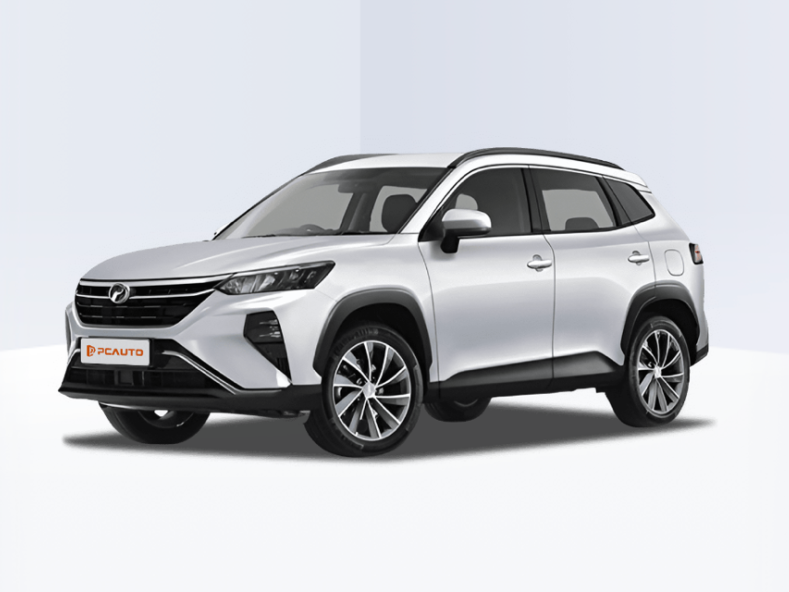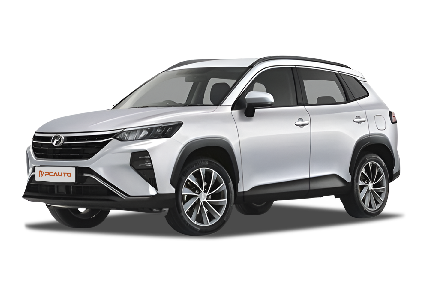Q
What are the engine specifications of the Perodua Nexis?
The Perodua Myvi, one of Malaysia's most beloved national cars, comes with a range of price tags depending on the variant and specs you go for. Right now, the latest Myvi models are going for roughly RM 46,000 to RM 62,000. The exact figure hinges on which trim you pick – think the 1.3L Standard G, 1.5L Premium X, or 1.5L AV. Each trim differs when it comes to engine size, safety kit, and tech features.
What makes the Myvi a hit? It's all about being wallet-friendly, sipping fuel gently, and boasting solid reliability – perfect for zipping around the city or family duties. Plus, it's packed with modern goodies like the ASA advanced safety suite, LED headlights, and smart key entry, giving you serious bang for your buck.
If you're watching your budget, the Myvi should be high on your list. Not only does it deliver great fuel economy, but it also offers a comfy drive and plenty of interior space, handling Malaysia's varied road conditions like a champ. On top of that, Perodua's widespread after-sales network and low maintenance costs add even more appeal, cementing the Myvi's status as a long-standing bestseller in the Malaysian market.
Special Disclaimer: This content is published by users and does not represent the views or position of PCauto.
Related Q&A
Q
Which Segment Does Perodua Nexis Belong to?
The Perodua Nexis falls into the B-Segment SUV category. This vehicle is positioned slightly higher than the Axia and Bezza in Perodua's product line. It mainly targets young family users who pursue space practicality and stylish design. The body size of the Perodua Nexis is expected to be similar to that of the Proton X50, but its price will be more affordable, continuing Perodua's characteristic of high cost - effectiveness.
B - Segment SUVs are very popular in the Malaysian market. Vehicles in this category usually have a relatively high ground clearance and flexible cabin space, which are suitable for the diverse local driving environments, including urban commuting and occasional countryside trips.
The Perodua Nexis is expected to be equipped with an energy - efficient 1.5L Dual VVT - i engine and may come with advanced safety systems such as ASA 3.0, continuing the brand's tradition of emphasizing fuel economy and safety.
For Malaysian consumers, B - Segment SUVs are a popular choice that combines practicality and a sense of trend. With its mature local production and a well - established after - sales service network, Perodua can often provide solutions that better meet local needs.hts.
Q
How much engine displacement of Perodua Nexis?
The Perodua Nexis has not been officially launched yet, so the official has not announced its specific engine displacement (CC) data. However, according to industry speculation, this upcoming B-segment SUV might be equipped with the same 1.0-liter three-cylinder turbocharged engine as the Perodua Ativa. The engine has a displacement of 998cc, a maximum power of 98 horsepower, and a peak torque of 140 N·m, and is paired with a D-CVT gearbox. If the final configuration turns out to be true, this small-displacement turbocharged engine can balance fuel economy and power performance, making it very suitable for the urban road conditions in Malaysia. Meanwhile, Perodua models generally adopt a lightweight design, which further optimizes fuel consumption. It is recommended that consumers keep an eye on the latest news from the official Perodua website or authorized dealers to get accurate information. When making a purchase, Malaysian car owners can also make a horizontal comparison with engines of similar models, such as the 1.5TGDI engine (1477cc) of the Proton X50 or the 1.5L naturally aspirated engine (1498cc) of the Honda HR-V. However, they need to pay attention to the differences in road tax, insurance, and maintenance costs among engines with different displacements.
Q
What Engine is used in Perodua Nexis?
The Perodua Nexis is expected to be equipped with a 1.5-liter Dual VVT-i naturally aspirated engine. This engine shares the technical platform with models like the Perodua Ativa and Toyota Rush. It has a maximum output power of about 106 horsepower and a peak torque of 138 Nm. It is paired with a D-CVT transmission, focusing on fuel economy and smoothness in daily driving. The engine adopts a dual variable valve timing system, which can optimize the intake and exhaust efficiency at both low and high speeds and meets the EURO 4 emission standards in the Malaysian market. For Malaysian users who value practicality, this kind of small-displacement engine can balance the fuel consumption during city commuting and the occasional long-distance needs, and the maintenance cost is relatively low. It's worth mentioning that Perodua has gradually upgraded its power technology in recent years. For example, a more efficient 1.0-liter turbocharged option has been applied to models like the Bezza. In the future, it may also offer a hybrid version for the Nexis to adapt to the market trend, but the specific details shall be subject to the official release. The engine design of this kind of compact SUV usually gives priority to durability in tropical climates. It is recommended that car owners conduct regular maintenance to ensure long-term performance.
Q
What is the Gearbox Type of Perodua Nexis?
As an upcoming all-new SUV model, the official details about the transmission type of the Perodua Nexis haven't been released yet. However, based on Perodua's consistent technical approach and market positioning, it's expected to be equipped with a proven D-CVT continuously variable transmission or a 4-speed automatic transmission. These two types of transmissions have been widely used in Perodua's existing models like the Aruz and Bezza. They are particularly suitable for the urban road conditions in Malaysia, balancing fuel economy and a smooth driving experience.
It's worth noting that the D-CVT transmission offers a more direct power response by simulating gear shifts, while the traditional automatic transmission is known for its durability and low maintenance costs. Consumers can choose according to their own driving habits. If the Nexis is positioned as a youthful SUV, more advanced transmission technologies may be introduced to enhance its competitiveness. It is recommended to follow Perodua's official press conference for the final configuration information.
Malaysian consumers can refer to the actual test - drive experience when making a purchase. The transmission tuning has a significant impact on the daily driving comfort. Meanwhile, the transmissions of all Perodua models have been locally adapted to suit the tropical climate and diverse road conditions.
Q
Does Perodua Nexis Support Apple Carplay?
As a newly launched model, it hasn't been officially confirmed whether the Perodua Nexis is equipped with Apple CarPlay. It is recommended that interested consumers directly contact Perodua dealers or check the official website for the latest configuration information. Apple CarPlay is a very practical in - vehicle connectivity technology. It allows iPhone users to directly use common functions such as navigation, music, and calls through the car's infotainment screen, enhancing driving convenience and safety. In the Malaysian market, more and more new cars are starting to be equipped with this feature, especially models from Japanese and local brands. If the Nexis gets this configuration in the future, its market competitiveness will be greatly enhanced. Apart from Apple CarPlay, Android Auto is also a similar in-vehicle connectivity system, which enables Android phone users to achieve the same convenient operations. For Malaysian consumers who value the technological experience, they can pay more attention to these smart connectivity configurations when buying a new car, as they can significantly improve the daily driving experience.
Q
What is the Tyre Brand of Perodua Nexis?
As the only part of the vehicle that contacts the ground, tires are crucial for driving safety, fuel consumption performance, and noise control. It is recommended that car owners give priority to products that match the original factory specifications (such as size 195/55 R16 or similar parameters) when replacing tires in the future. Also, pay attention to the tread wear indicator lines to ensure safety. If you're after better performance, you can consider upgrading to silent or energy-saving tires after the warranty period. But be aware that modifications may affect the original factory warranty terms, so it's advisable to consult an authorized service center.
In Malaysia's rainy climate, it's particularly important to choose tire treads with strong wet-grip performance. Regularly checking tire pressure and the aging condition of the tires is also basic maintenance knowledge.
Q
Is Perodua Nexis a Good Car? Learn the Pros and Cons Here
As an upcoming all-new SUV model, the currently official information reveals that the Perodua Nexis is positioned as a B-segment urban SUV. It is expected to be powered by a combination of a 1.5L Dual VVT-i engine and a D-CVT gearbox. This market-proven powertrain has advantages in terms of fuel economy and maintenance costs, making it particularly suitable for the urban road conditions in Malaysia and consumers' demand for practicality. Judging from the released teaser images, the Nexis adopts Perodua's latest family design language. The body lines are more sporty. The interior is expected to continue the brand's layout style that emphasizes functionality and may be equipped with an advanced ASA active safety system, which is quite attractive to Malaysian family users who value safety. Although the specific configuration and price have not been announced yet, referring to Perodua's consistent market strategy, the Nexis is likely to follow the high-cost-performance route, competing differently with the Proton X50 and providing consumers with a more affordable SUV option. It is recommended that potential buyers pay attention to the upcoming detailed specifications and take a test drive to experience its space performance and handling feel. At the same time, compare the after-sales warranty policies of models in the same class. After all, a 5-year warranty period has become the mainstream standard in the Malaysian market, and Perodua's nationwide service center network is a remarkable advantage for its after-sales service.
Q
What is the Second Hand Price of Perodua Nexis? Check Used Price Here
Normally, used - car prices are affected by multiple factors such as the vehicle's age, mileage, condition, maintenance records, and market demand. Take other popular Perodua models like the Myvi or Axia as an example. The used - car prices of vehicles with a 1 - 3 - year age are approximately 60% - 80% of the original price, but the specific price depends on the configuration and market supply and demand.
If you're considering buying a used car, it is advisable to check vehicles that have undergone professional inspections through authorized dealers or certified platforms. At the same time, pay attention to checking the Service Book to confirm the maintenance history, and it is recommended to take a test drive to confirm the mechanical condition.
For models about to be launched, you can also refer to the depreciation curves of similar - positioned models of the same brand as a future reference. However, note that the application of new technologies or differences in configurations may cause price fluctuations.
Q
What is the Fuel Consumption of Perodua Nexis?
As an upcoming all-new SUV model, the official fuel consumption data of the Perodua Nexis has not been officially released yet. But referring to Perodua's consistent use of energy-saving technologies such as the DVVT dual variable valve timing system and lightweight body design, it is expected that its fuel economy will continue the brand's advantage, possibly ranging from 5.0 to 6.5 liters per 100 kilometers. The specific performance depends on the actual power configuration (such as a 1.5L naturally aspirated engine or a hybrid system) and driving conditions.
For Malaysian consumers, in the daily use scenarios of urban commuting combined with highway sections, this kind of compact SUV can usually balance power and fuel consumption. It is recommended to pay attention to the actual test data released by the subsequent PUSPAKOM certification or the Energy Efficiency Label (EEV).
It is worth mentioning that fuel consumption is significantly affected by driving habits, road conditions, and maintenance status. Regularly maintaining tire pressure and avoiding rapid acceleration and deceleration can improve fuel efficiency. And the reasonable use of air conditioning in Malaysia's hot climate is also a key factor in optimizing energy consumption.
If you have higher requirements for energy efficiency, you can compare it with models in the same class, such as the 1.5TGDI engine of the Proton X50, or wait for the technical details of Perodua's potential hybrid version.
Q
Is Perodua Nexis Worth Buying? Check out Its Features Here!
The Perodua Nexis, as an upcoming all-new SUV model, is truly worth the attention of Malaysian consumers. It is expected to be equipped with a 1.5L Dual VVT-i engine, paired with a D-CVT transmission, offering a smooth driving experience and good fuel economy, which is suitable for daily commuting and family use. Based on the known information, the Nexis might be equipped with advanced safety systems such as ASA 3.0 (Advanced Safety Assist) and six airbags, which are quite competitive among models in the same class. The interior space is expected to continue Perodua's consistent practicality. The rear seats can be folded down to increase the luggage capacity, meeting the multi - purpose needs of Malaysian families. Although the official has not yet announced the full configuration and price, referring to Perodua's high - cost - performance strategy for previous models like the Ativa and Aruz, the Nexis is very likely to continue this advantage. For consumers with a budget of around 100,000 ringgit who are looking for reliability and practicality, they might as well wait for more official information before making a decision. Given Malaysia's rainy and hot climate, it is recommended that consumers pay extra attention to the vehicle's air - conditioning cooling effect and anti - rust process when buying a car. These details can often enhance the long - term driving experience.
Popular Cars
Model Year
Car Compare
Car Photo
Latest Q&A
Q
Is the 1.5 L 4 cylinder?
Yes, a 1.5L engine is typically a 4-cylinder setup—the most common configuration for small to mid-sized displacements. This layout strikes a solid balance between fuel efficiency and power output, making it ideal for daily commuting and family use. Four-cylinder engines are relatively simple in design, cheaper to maintain, and benefit from proven technology that delivers smooth operation. You'll find this configuration widely used by mainstream brands like Honda, Toyota, and Mazda. While there are some 1.5L 3-cylinder options out there, the 4-cylinder remains the go-to choice, especially in models prioritizing durability and refinement. If you're shopping for a 1.5L-powered car, pay attention to specific tech features—turbocharging, direct injection, etc.—as these can significantly impact real-world driving dynamics and fuel economy.
Q
What is the displacement of a V8 engine?
The displacement of a V8 engine typically ranges from 4.0 to 6.2 liters, depending on the vehicle and its purpose. For example, high-performance sports cars often pack a 5.0-liter or larger V8, while trucks and SUVs usually stick with something between 4.3 and 5.7 liters. Known for its brute power and smooth operation, the V8 is a go-to for acceleration and towing—though its thirst for fuel is something buyers always weigh up.
These days, turbocharging has changed the game. Smaller-displacement V8s (like a twin-turbo 4.0L) can now deliver big-block performance with slightly better efficiency. And let’s not forget the sound—few things beat the roar of a tuned V8 exhaust, a big reason why enthusiasts love ‘em.
If you’re into V8s, keep an eye on local used car listings or auto shows—you’ll often spot some gems there.
Q
What is the difference between 1l and 1.2 L engine?
The key difference between 1-liter (1L) and 1.2-liter (1.2L) engines comes down to displacement—the total volume of all cylinders in an engine, measured in liters. Generally, a larger displacement means more power and torque, so a 1.2L engine will likely feel stronger during acceleration, highway driving, or when tackling hills with a load. That said, it’ll also drink a bit more fuel compared to the 1L.
The 1L, being smaller, prioritizes fuel efficiency, making it a smart pick for city commuting or everyday runs. On the flip side, the 1.2L’s extra performance often means higher manufacturing costs, which might bump up the car’s price tag. Plus, the 1L’s compact size fits better in smaller or budget-friendly models.
Your choice really hinges on driving needs: go for the 1.2L if you regularly hit the highway or want more grunt, but stick with the 1L if you’re mostly urban-bound and watching fuel bills. Oh, and don’t forget—tech like turbocharging or variable valve timing can squeeze near-equal performance from smaller engines these days, so specs alone don’t tell the full story. Always check how the engine’s tuned.
Q
What does 5.7 liter engine mean?
A 5.7-liter engine refers to a total displacement of 5.7 liters, meaning all cylinders combine for a total working volume of 5,700 cubic centimeters. Generally, a larger displacement allows the engine to take in more air and fuel, delivering stronger power and torque—making it ideal for performance-oriented vehicles or those built for heavy-duty work, like pickup trucks, full-size SUVs, or muscle cars.
In the local market, you’ll often find big-displacement engines in American-branded vehicles. These engines excel at high-speed cruising or towing heavy loads, though they do come with higher fuel consumption and increased running costs.
Thanks to advancing technology, many automakers now use turbocharging or hybrid systems to help smaller engines deliver power comparable to older, larger naturally aspirated units—like how some modern 2.0L turbocharged engines can match the performance of older V6 engines while being far more fuel-efficient.
If fuel economy is a priority, a smaller turbocharged or hybrid model might be the better choice. But if you value the smooth, raw power of a classic big-block, a 5.7-liter engine remains a timeless option.
Q
What liter engine is a V6?
The displacement of a V6 engine isn't set in stone—it typically ranges between 2.5 and 4.0 liters, depending on the vehicle's design and purpose. For example, a family sedan might pack a 2.5L or 3.0L V6, while performance cars or pickups could go for 3.5L or larger. Displacement directly impacts power output and fuel economy: bigger usually means stronger, but thirstier too.
Named for its six cylinders arranged in a V-shape, the V6 strikes a sweet spot—delivering smoother operation and better balance in a compact package compared to four-cylinder engines, while being more fuel-efficient than V8s. That's why it's a popular choice for midsize sedans and SUVs.
These days, with turbocharging becoming commonplace, smaller-displacement V6 turbos can match the punch of older, bigger engines while sipping less fuel. Choosing one? Think about your daily needs. A 2.5L works fine for city commutes, but if you're frequently hitting the highway or towing, step up to 3.0L or above.
View MoreRelated News

Perodua Nexis / Traz (D66B) how much will it sell for?
RobertDec 17, 2025

Perodua D66B teaser revealed, a new B-segment SUV based on the Yaris Cross is coming soon
WilliamDec 10, 2025

Should I choose Proton X50, or continue waiting for the repeatedly disappointing Perodua Nexis?
JohnNov 22, 2024

Will Perodua Nexis (D66B) Compete with Proton X50?
LienJun 19, 2024

Perodua Traz receives ASEAN NCAP five-star safety rating, surpassing Toyota Yaris Cross
RobertDec 18, 2025
View More

















Pros
Cons